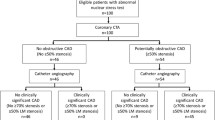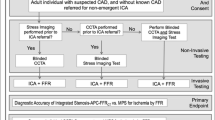Abstract
To evaluate the utility of CT coronary angiography (CTA) for demonstrating coronary artery disease in inner-city outpatients, we prospectively compared CTA with stress SPECT myocardial perfusion imaging in an ethnically diverse, gender balanced population. All patients gave written informed consent for this IRB approved, HIPAA compliant study. Sixty-one patients completed both CTA and SPECT. About 67% were ethnic minorities, 51% were women. A stenosis of ≥70% on CTA was considered positive. Results were compared with perfusion defects on SPECT and correlated with clinical endpoints (hospital admissions, cardiovascular events, coronary interventions and deaths). CTA and SPECT data were compared with results of coronary angiography, when performed. There was moderate global agreement of 79% (48/61) between CTA and SPECT, κ = 0.483 (SE ± 0.13, P = 0.0001). With SPECT as the reference standard, CTA had sensitivity of 73% (11/15), specificity of 80% (37/46), negative predictive value of 90% (37/41) and positive predictive value of 55% (11/20). Positive SPECT was associated with positive CTA, (P < 0.0001, OR = 22). Eleven (18%) underwent subsequent cardiac catheterization, which was positive in 91% (10/11). CTA and SPECT had positive predictive values of 90 and 83% compared with catheterization. This study lends preliminary evidence to support to the utility of CTA as an alternative modality for the evaluation of CAD in an ethnically diverse, gender balanced inner-city outpatient population. Similar to more homogenous groups, CTA had a high negative predictive value and demonstrated disease occult to SPECT. Further study is necessary to evaluate the impact of CTA on patient outcomes.


Similar content being viewed by others
References
DiCarli MF, Hachamovitch R (2007) New technology for noninvasive evaluation of coronary artery disease. Circulation 115:1464–1480
Vanhoenacker PK, Heijenbrok-Kal MH, Van Heste R et al (2007) Diagnostic performance of multidetector CT angiography for assessment of coronary artery disease: meta-analysis. Radiology 244(2):419–428
Sun Z, Lin C, Davidson R et al (2007) Diagnostic value of 64-slice CT angiography in coronary artery disease: a systematic review. Eur J Radiol 67(1): 78–84
Hendel RC, Patel MR, Kramer CM (2006) ACCF/ACR/SCCT/SCMR/ASNC/NASCI/SCAI/SIR 2006 appropriateness criteria for cardiac computed tomography and cardiac magnetic resonance imaging: a report of the American College of Cardiology Foundation Quality Strategic Directions Committee Appropriateness Criteria Working Group, American College of Radiology, Society of Cardiovascular Computed Tomography, Society for Cardiovascular Magnetic Resonance, American Society of Nuclear Cardiology, North American Society for Cardiac Imaging, Society for Cardiovascular Angiography and Interventions, and Society of Interventional Radiology. J Am Coll Cardiol 48(7):1475–1497
Pundziute G, Schuijf JD, Jukema JW et al (2007) Prognostic value of multislice computed tomography coronary angiography in patients with known or suspected coronary artery disease. J Am Coll Cardiol 49(1):62–70
Min JK, Shaw LJ, Devereux RB et al (2007) Prognostic value of multidetector coronary computed tomographic angiography for prediction of all-cause mortality. J Am Coll Cardiol 50:1161–1170
Shaw LJ, Iskandrian AE (2004) Prognostic value of gated myocardial perfusion SPECT. J Nucl Cardiol 11:171–185
Hachamovitch R, Berman DS, Shaw LJ, Kiat H, Cohen I, Cabico JA, Friedman J, Diamond GA (1998) Incremental prognostic value of myocardial perfusion single photon emission computed tomography for the prediction of cardiac death. Differential stratification for risk of cardiac death and myocardial infarction. Circulation 97:535–543
Hachamovitch R, Hayes SW, Friedman JD, Cohen I, Berman DS (2003) Comparison of the short-term survival benefit associated with revascularization compared with medical therapy in patients with no prior coronary artery disease undergoing stress myocardial perfusion single photon emission computed tomography. Circulation 107:2900–2906
Sun Z, Jiang W (2006) Diagnostic value of multislice computed tomography angiography in coronary artery disease: a meta-analysis. Eur J Radiol 60(2):279–286
Gallagher MJ, Ross MA, Raff GL et al (2007) The diagnostic accuracy of 64-slice computed tomography coronary angiography compared with stress nuclear imaging in emergency department low-risk chest pain patients. Ann Emerg Med 49(2):125–136
Goldstein JA, Gallagher MJ, O’Neill WW et al (2007) A randomized controlled trial of multi-slice coronary computed tomography for evaluation of acute chest pain. J Am Coll Cardiol 49(8):863–871
Hacker M, Jakobs T, Matthiesen F et al (2005) Comparison of spiral multidetector CT angiography and myocardial perfusion imaging in the noninvasive detection of functionally relevant coronary artery lesions: first clinical experiences. J Nucl Med 46(8):1294–1300
Hacker M, Jakobs T, Hack N et al (2007) Sixty-four slice spiral CT angiography does not predict the functional relevance of coronary artery stenoses in patients with stable angina. Eur J Nucl Med Mol Imaging 34(1):4–10
Schuijf JD, Wijns W, Jukema JW et al (2006) Relationship between noninvasive coronary angiography with multi-slice computed tomography and myocardial perfusion imaging. J Am Coll Cardiol 48(12):2508–2514
Gaemperli O, Schepis T, Koepfli P et al (2007) Accuracy of 64-slice CT angiography for the detection of functionally relevant coronary stenoses as assessed with myocardial perfusion SPECT. Eur J Nucl Med Mol Imaging 34:1162–1171
Diamond GA, Forrester JS (1979) Analysis of probability as an aid in the clinical diagnosis of coronary-artery disease. N Engl J Med 300:1350–1358
Berman DS, Kiat H, Friedman J et al (1993) Separate acquisition rest thallium-201/stress Tc-99m sestamibi dual isotope myocardial perfusion SPECT: a clinical validation study. J Am Coll Cardiol 22:1455–1464
DePuey EG, Corbett JR, Friedman JD, Goldstein RA, Hansen DL, Henzlova MJ, Machac J, Nichols KJ, Tilkemeier PL (2006) ASNC imaging guidelines for nuclear cardiology procedures: a report of the American Society of Nuclear Cardiology Quality Assurance Committee; June 2006. http://www.asnc.org/section_73.cfm. Accessed 3 August 2006
Ragosta M, Bishop AH, Lipson LC et al (2007) Comparison between angiography and fractional flow reserve versus single-photon emission tomographic myocardial perfusion imaging for determining lesion significance in patients with multivessel coronary disease. Am J Cardiol 99:896–902
Dahlberg S, Leppo J (2003) Risk stratification of the normal perfusion scan: does normal stress perfusion always mean very low risk? J Nucl Cardiol 10:87–91
Heller GV (1996) Tracer selection with different stress modalities based on tracer kinetics. J Nucl Cardiol 3:S15–S21
Sand NP, Rehling M, Bagger JP et al (2000) Functional significance of recruitable collaterals during temporary coronary occlusion evaluated by 99mTc-sestamibi single-photon emission computerized tomography. J Am Coll Cardiol 35:624–632
Travin MI (2007) Is it possible for myocardial perfusion imaging to avoid missing any patients with high-risk coronary disease? J Nucl Cardiol 14:492–496
Boden WE, O’Rourke RA, Teo KT et al (2007) Optimal medical therapy with or without PCI for stable coronary disease. N Engl J Med 356:1503–1516
Henderson RA, Pocock SJ, Clayton TC et al (2003) Seven-year outcome in the RITA-2 trial: coronary angioplasty versus medical therapy. J Am Coll Cardiol 42(7):1161–1170
Parisi AF, Folland ED, Hartigan P (1992) A comparison of angioplasty with medical therapy in the treatment of single-vessel coronary artery disease. Veterans affairs ACME investigators. N Engl J Med 326:10–16
Pitt B, Waters D, Brown WV et al (1999) Aggressive lipid lowering therapy compared with angioplasty in stable coronary artery disease. N Engl J Med 341:70–76
Giroud D, Li JM, Urban P, Meier B, Rutishauer (1992) Relation of the site of acute myocardial infarction to the most severe coronary arterial stenosis at prior angiography. Am J Cardiol 69:729–732
Schuijf JD, Wijns W, Jukema JW et al (2006) A comparative regional analysis of coronary atherosclerosis and calcium score on multislice CT versus myocardial perfusion on SPECT. J Nucl Med 47:1749–1755
Schepis T, Gaemperli O, Koepfli P et al (2007) Added value of coronary artery calcium score as an adjunct to gated SPECT for the evaluation of coronary artery disease in an intermediate risk population. J Nucl Med 48:1424–1430
Iskandrian AS, Chae SC, Heo J, Stanberry CD, Wasserleben V, Cave V (1993) Independent and incremental prognostic value of exercise single-photon emission computed tomographic (SPECT) thallium imaging in coronary artery disease. J Am Coll Cardiol 22:665–670
Pijls NH, van Schaardenburgh P, Manoharan G et al (2007) Percutaneous coronary intervention of functionally nonsignificant stenosis: 5-year follow-up of the DEFER study. J Am Coll Cardiol 49:2105–2111
Acknowledgments
This research protocol could not have been completed without the help of a large and dedicated team. We thank Menachem M. Gold, MD, Calvin Lo, MD and Divya Malhotra, MD for their valuable contributions in preparing the IRB proposal and the patient informed consent. We thank Eric Wasp, PA, Zehra Ahmed, PA and Melanie Aure, PA for their assistance in expediting the care of patients participating in this research protocol. We thank Steven Sheh, Rebecca Altschul, Brian Chou, Martha Gomez and Charadin Frank for their assistance in patient recruitment. We thank Alpesh Mehta for obtaining patient follow-up. We thank Jonathan N. Tobin, PhD and Sylvia Wassertheil-Smoller, PhD for their assistance with study design. Supported in-part by a research grant from GE Healthcare.
Author information
Authors and Affiliations
Corresponding author
Rights and permissions
About this article
Cite this article
Haramati, L.B., Levsky, J.M., Jain, V.R. et al. CT angiography for evaluation of coronary artery disease in inner-city outpatients: an initial prospective comparison with stress myocardial perfusion imaging. Int J Cardiovasc Imaging 25, 303–313 (2009). https://doi.org/10.1007/s10554-008-9382-5
Received:
Accepted:
Published:
Issue Date:
DOI: https://doi.org/10.1007/s10554-008-9382-5




